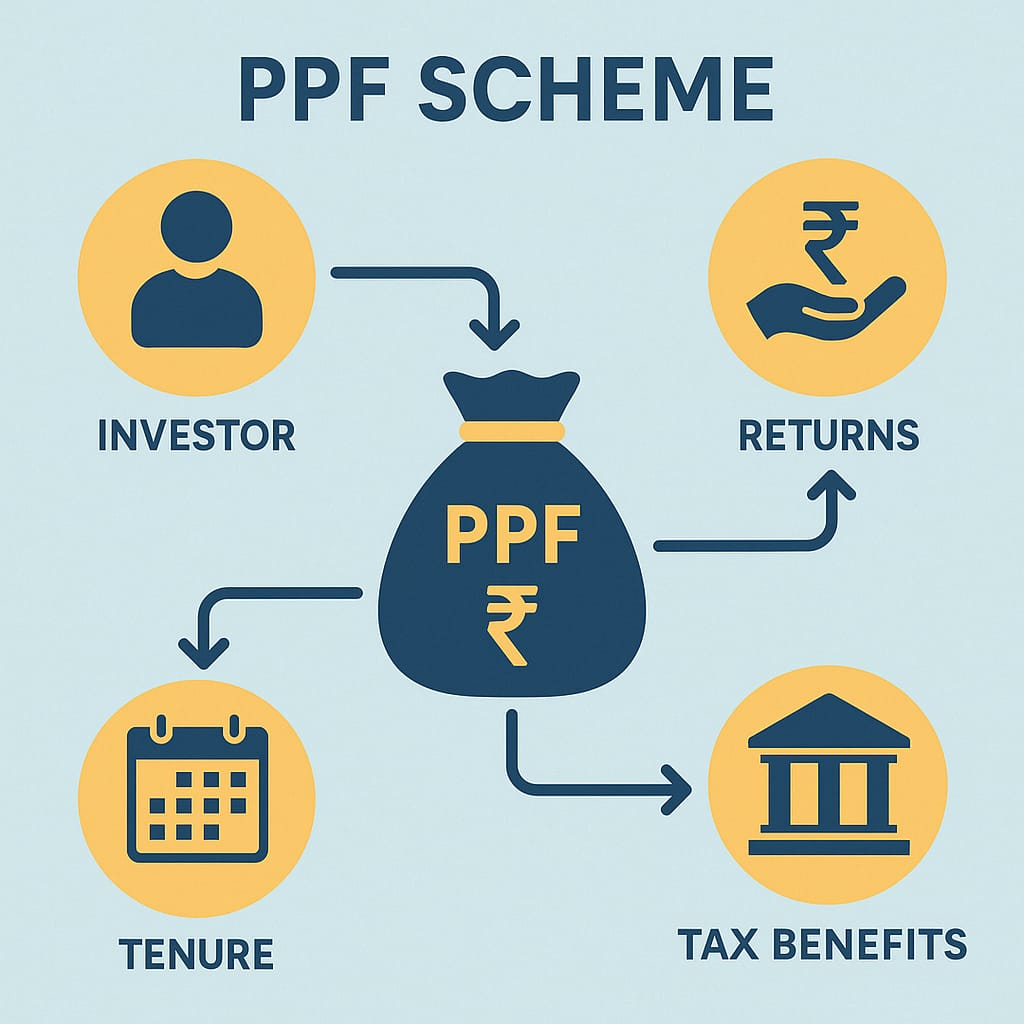
What is PPF?
In 1968, the government established the Public Provident Fund (PPF) to encourage small savings by offering an investment option with decent returns and income tax benefits.
It is a long-term savings plan that has a 15-year lock-in period.
The Central Government provides a sovereign guarantee on PPF, ensuring your investment remains completely safe.
Key Features of PPF
- Backed by the Government of India (safe investment)
- Tenure of 15 years (extendable)
- Interest compounded annually
- Tax-free interest and maturity amount
- Partial withdrawals and loans allowed
- Minimum deposit: 500/year
- Maximum deposit: 1.5 lakhs/year
Income Tax Benefits
- Contributions to PPF are eligible for deduction under Section 80C of the Income Tax Act (up to ₹1.5 lakh per year).
- Interest earned is tax-free.
- Maturity proceeds are also tax-free.
Eligibility
- Only resident individuals can open a PPF account.
- You can open only one PPF account in your name.
- A parent/guardian can open a PPF account for a minor child.
PPF for NRIs
- NRIs cannot open a new PPF account as per government rules.
- If a resident becomes an NRI after opening a PPF account, they can continue the account till maturity but cannot extend it after 15 years.
HUF
- HUFs cannot open new PPF accounts under current government rules.
- The government allowed existing PPF accounts held by HUFs (opened before May 13, 2005) to continue until maturity but does not allow extensions.
Where Can You Open a PPF Account?
You can open a PPF account at:
- Any Nationalised Bank of India (SBI, HDFC, ICICI, Axis, etc.)
- India Post Offices
- Through online banking portals of major banks
Deposit Amount
- Minimum: 500/- per financial year
- Maximum: 1.5 lakhs per financial year
- You can deposit the amount in a lump sum or in up to 12 installments per year.
Best Time to Deposit
- To maximize interest, deposit the full amount (or regular monthly deposits) before the 5th of each month.
- Best strategy: Invest the full ₹1.5 lakh at the beginning of the financial year, ideally before April 5th.
In-active Accounts
- If you don’t deposit the minimum 500 per year, the system marks your account as inactive.
- To reactivate: Pay a 50 penalty per year of default plus minimum 500 per missed year.
- No loans or withdrawals allowed while the account is inactive.
Interest on PPF
- The government sets the interest rate every quarter.
- For Q1 FY 2025-26 (April–June), the rate is 7.1% p.a. (as an example – always check the current rate).
- Interest is tax-free.
Compounding Frequency
- The system compounds the interest annually.
- Calculated on the lowest balance between 5th and end of each month.
Loan Against PPF
- You can take loans between the 3rd and 6th financial year.
- Maximum: 25% of the balance at the end of the 2nd year preceding the loan year.
- Interest rate: 1% higher than the applicable PPF interest rate.
- You must repay the loan within 36 months.
Withdrawal from PPF
- Partial withdrawals allowed from the 7th financial year.
- Maximum withdrawal: 50% of the balance at the end of the 4th year preceding or immediate preceding year, whichever is lower.
Maturity Period
- PPF account matures 15 years after the end of the financial year in which you opened it.
You can:
- Withdraw the full amount tax-free
- Extend the account with or without deposits
Extension Without Deposits
- You can extend the PPF account in blocks of 5 years, as many times as you want.
- You don’t need to submit Form H.
- No fresh deposits allowed, but interest continues to accumulate.
Extension With Deposits
- Submit Form H within one year of maturity.
- Continue depositing up to 1.5 lakhs/year.
- You can repeatedly extend the account in 5-year blocks.
Premature Closure
Allowed after 5 financial years, only for specific reasons:
- Medical treatment (self/family)
- Higher education (self/children)
- Change in residency status (becoming an NRI)
- Penalty: 1% reduction in interest for entire period.
Nomination
- You can nominate one or more persons to receive the proceeds on your death.
- You can make a nomination when opening the account or update it later.
Account Transfer
You can transfer PPF accounts between:
- Post Office and Bank
- Between different branches
- Between Post Offices
Note: Transfer does not affect interest or tenure. No fee charged.
Final Thoughts
The Public Provident Fund is ideal for conservative investors looking for guaranteed returns, tax benefits, and a disciplined way to save over the long term.
Despite the 15-year lock-in, the liquidity via partial withdrawals and loans makes it a flexible choice for long-term goals like retirement or children’s education.
